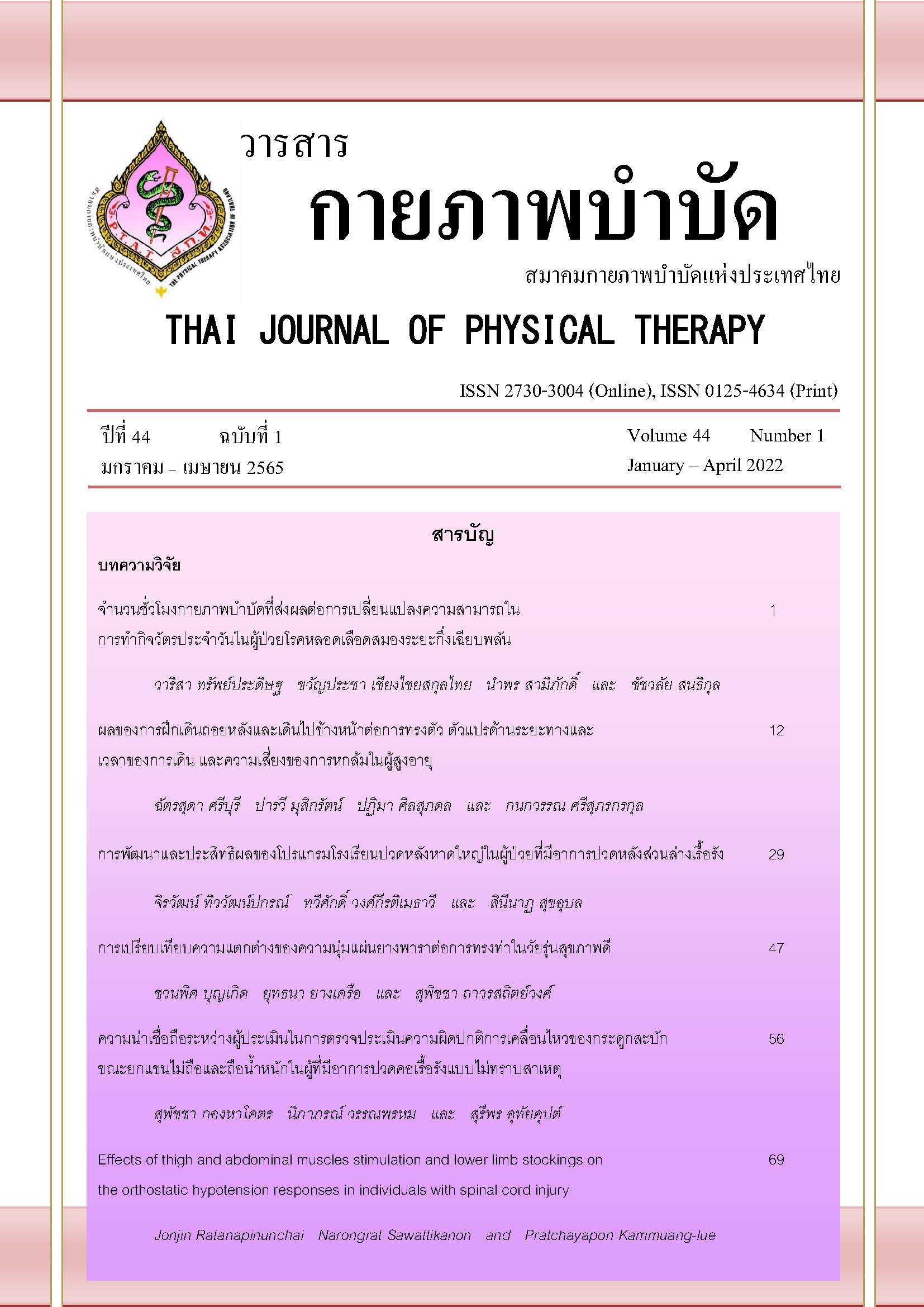การเปรียบเทียบความแตกต่างของความนุ่มแผ่นยางพาราต่อการทรงท่าในวัยรุ่นสุขภาพดี
Main Article Content
บทคัดย่อ
ที่มาและความสำคัญ: การฝึกการทรงตัวเป็นเทคนิคการฟื้นฟูที่มีประสิทธิภาพช่วยเพิ่มความสามารถในการควบคุมการทรงท่าโดยท้าทายตำแหน่งของร่างกายให้ทรงตัวอยู่ได้ในพื้นที่ฐานรองรับน้ำหนัก แผ่นโฟมเป็นอุปกรณ์ที่นิยมใช้สำหรับการฝึกการทรงตัวในทางคลินิก อย่างไรก็ตาม แผ่นโฟมสังเคราะห์จากพลาสติกนั้นมีราคาที่ค่อนข้างสูงทำให้เข้าถึงได้ยากและเป็นมลพิษต่อสิ่งแวดล้อม ขณะที่ยางพาราเป็นวัสดุธรรมชาติที่มีคุณสมบัติให้ความยืดหยุ่นและมีความทนทานเช่นเดียวกันกับแผ่นโฟมแต่มีราคาที่ถูกกว่า เข้าถึงได้ง่าย และไม่เป็นพิษต่อผู้ใช้งาน
วัตถุประสงค์: เพื่อศึกษาผลความแตกต่างของความนุ่มแผ่นยางพาราต่อการควบคุมการทรงท่าในวัยรุ่นสุขภาพดี
วิธีการวิจัย: ผู้เข้าร่วมงานวิจัยเป็นผู้ที่มีสุขภาพดี จำนวน 20 คน (ชาย 3 คน และหญิง 17 คน; อายุเฉลี่ย 22.06 ± 0.84 ปี; ค่าดัชนีมวลกายเฉลี่ย 22.08 ± 3.51 กิโลกรัมต่อเมตร2) ประเมินความสามารถในการทรงท่าโดยใช้ ความเร็วจุดศูนย์กลางแรงดัน (COP velocity) และระยะทางการเคลื่อนที่จุดศูนย์กลางแรงดัน (COP displacement) ขณะยืนทรงตัวและหลับตาบนแผ่นฝึกการทรงตัว 5 ชนิด ได้แก่ แผ่นโฟม Airex และแผ่นยางพาราความนุ่ม 4 ระดับ โดยสุ่มลำดับแผ่นในการทดสอบ เปรียบเทียบความแตกต่างของความเร็วจุดศูนย์กลางแรงดัน (COP velocity) และระยะทางการเคลื่อนที่จุดศูนย์กลางแรงดัน (COP displacement) โดยใช้สถิติ One-way repeated measure ANOVA และใช้ Bonferroni post hoc analysis เพื่อเปรียบเทียบคู่ที่แตกต่าง
ผลการวิจัย: พบความแตกต่างกันอย่างมีนัยสำคัญของค่า ความเร็วและระยะทางในการเคลื่อนที่จุดศูนย์กลางแรงดัน ระหว่างแผ่นยางพาราความนุ่มระดับ 1 และ 4 กับ แผ่นยางพาราความนุ่มระดับ 2, 3 และแผ่นโฟม (Airex) (p<0.001)
สรุปผล: จากการศึกษา พบว่าความนุ่มของแผ่นยางพารามีผลต่อความสามารถในการทรงท่าในวัยรุ่นสุขภาพดี ซึ่งยางพาราความนุ่มระดับ 2 และ 3 อาจจะสามารถใช้เป็นอุปกรณ์ทดแทนที่มีราคาถูกในการตรวจประเมินและฝึกการทรงตัว
คำสำคัญ: การทรงตัว แผ่นยางพารา ความนุ่ม
Article Details

อนุญาตภายใต้เงื่อนไข Creative Commons Attribution-NonCommercial-NoDerivatives 4.0 International License.
เอกสารอ้างอิง
St-Pierre F. Analysis of static and /or Dynamic Posture on Force Platform (Posturography). St-Denis La Plaine, France: Department of Medical and Surgical Procedure Assessment, Haute Authorite de Sante; 2007.
McKeon PO, Ingersoll CD, Kerrigan DC, Saliba E, Bennett BC, Hertel J. Balance training improves function and postural control in those with chronic ankle instability. Med Sci Sports Exerc 2008; 40(10): 1810-9.
Hall EA, Chomistek AK, Kingma JJ, Docherty CL. Balance- and Strength-Training Protocols to Improve Chronic Ankle Instability Deficits, Part I: Assessing Clinical Outcome Measures. J Athl Train 2018; 53(6): 568-77.
Siriphorn A, Chamonchant D, Boonyong A. Comparison of the effect of a foam pad, mung bean bag and plastic bead bag on postural stability disturbance in healthy young adults. J Phys Ther Sci 2016; 28:530-4.
Donath L, Roth R, Zahner L, Faude O. Testing single and double limb standing balance performance: Comparison of COP path length evaluation between two devices. Gait Posture 2012; 36: 439-43.
Lin D, Seol H, Nussbaum MA, Madigan ML. Reliability of COP-based postural sway measures and age-related differences. Gait Posture 2008; 28: 337-42.
Hirase T, Inokuchi S, Matsusaka N, Okita M. Effects of a Balance Training Program Using a Foam Rubber Pad in Community-Based Older Adults: A Randomized Controlled Trial. J Geriatr Phys Ther 2015; 38:62-70.
Mastusaka N, Yokoyama S, Tsurusaki T, Inikuchi A, Okita M. Effect of ankle disc training combined with tactile stimulation to the leg and foot on functional instability of the ankle. Am J Sports Med 2001; 29(1):25-30.
Patel M, Fransson PA, Lush D, Gomez S. The effect of foam surface properties on postural stability assessment while standing. Gait Posture 2008; 28:649-56.
Lee D, Kim H, An H, Jang J, Hong S, Jung S, Lee K, Choi M-R, Lee K-H, Lee G. Comparison of Postural sway depending on balance pad type. J Phys Ther Sci 2018; 30: 252-7.
Lin CC, Roche JL, Steed DP, Musolino MC, Marchetti GF, Furman GR, Sedfern MS, Whitney SL. Test-retest reliability of postural stability on two different foam pads. J Nat Sci 2015; 1(2): 1-12.
Boonsinsukh R, Khumnonchai B, Saengsirisuwan V, Chaikeeree N. The effect of the type of foam pad used in the modified Clinical Test of Sensory Interaction and Balance (mCTSIB) on the accuracy in identifying older adults with fall history. Hong Kong Physiother J 2020; 40(2):133-43.
Patel M, Fransson PA, Lush D, Petersen H, Magnusson M, Johansson R, Gomez S. The effects of foam surface properties on standing body movement. Acta Otolaryngol 2008; 128(9): 952-60.
Chaikeeree N, Saengsirisuwan V, Chinsongkram B, Boonsinsukh R. Interaction of age and foam types used in Clinical Test for Sensory Interaction and Balance (CTSIB). Gait Posture 2015; 41(1): 313-5.
Bey ME, Arampatzis A, Legerlotz K. The effect of a maternity support belt on static stability and posture in pregnant and non-pregnant women. J Biomech 2008; (75): 123-8.
Pyykko I, Jantti P, Aalto H. Postural control in elderly subjects. Age Ageing 1990; 19(3):215-21.
List R, Hitz M, Angst M, Taylor WR, Lorenzetti S. In-situ force plate calibration: 12 years' experience with an approach for correcting the point of force application. Gait Posture 2017; 58: 98-102.
Gosselin G, Fagan M. Foam pads properties and their effects on posturography in participants of different weight. Chiropr Man Therap 2015; 23(1): 2.
Liu B, Leng Y, Zhou R, Liu J, Liu D, Liu J, Zhang S-L, Kong WJ. Foam pad of appropriate thickness can improve diagnostic value if foam posturography in detecting postural instability. Acta Otolaryngol 2018; 138(4): 351-6.
Nam H-S, Kim J-H, Lim Y-J. The Effect of the Base of Support on Anticipatory Postural Adjustment and Postural Stability. J Kor Phys Ther 2017; 29(3): 135-41.
Surarangsit T, Krityakiarana W, Khongprasert S. Comparison of postural stability between dancers and healthy with and without chronic ankle instability. Journal Sports Science and Health 2019; 20(2): 26-39.
Chatchawan U. Physical therapy in ankle sprain. J Med Tech Phy Ther 2001; 13(1): 1-14.
Kim JW, Eom G-M, Kim C-S, Kim D-H, Lee J-H, Park BK, Hong J. Sex differences in the postural sway characteristics of young and elderly subjects during quiet natural standing. Geriatr Gerontol Int 2010; 10: 191-8.


